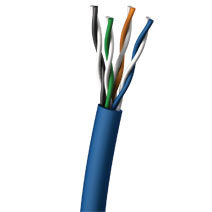Huge Selection of Cat5e and Cat6 Network Cables

If you are evaluating your options on which twisted pair cable type you should use to transmit data in your networking or home theater application there is a good chance you keep running into the same cables. Cat5e and Cat 6 is the most popular network cable types used in both residential and commercial UTP cabling applications. Organizations like the Telecommunication Industry Association (TIA) and Electronic Industries Association (EIA) have created specific standards that have been used to classify all twisted pair cables based on their performance levels.
Use the Cat5e cable the professionals use!
Cat5e Cable:
Cat5e means Category 5, enhanced. Cat5e can handle data transfer at 1000 Mbps and is suitable for Gigabit Ethernet applications. Most Cat5e cables are unshielded although you can buy it in shielded and direct burial types. This is the most common cable used for structured cabling applications such as computer network and telecommunication installations. The specification for Cat5e network cable is defined by ANSI/EIA-568-A which is a telecommunications standard that addresses commercial building cabling for telecom products and services. Most commonly Cat5e network cable is a 4 pair 24 AWG cable and is offered in both stranded and solid construction. A high quality Cat5e cable is manufactured TIA 568-C.2 industry standards and is UL and cUL listed and verified.
Cat 6 Cable:
Cat 6 cable is also manufactured to a standard for Gigabit Ethernet applications and other network protocols that are backward compatible with the Category 5/5e and Category 3 cable standards. Compared to Cat5e cable the Cat 6 is a thicker gauge of cable (23 AWG) and provides performance of up to 250 MHz. Most quality Cat 6 cables exceed specifications and will reach performance up to 550 MHz. What it all means is that Cat 6 is thicker, and has more copper, which means a bigger pipe to transfer data.
The great debate:
By now you are most likely scratching your head trying to figure out which network cable is right for your network installation. If you are using network components that are Gigabit rated and calls for certified gigabit performance then Cat 6 is the cable for you. This also means that every component end to end must be rated for Gigabit performance. This includes Cat 6 jacks, connectors, and patch panels. If this is not the case then using Cat 6 cable will not help you. You will also need all the tool to terminate the connectors used to support your Cat 6 network.
Cat5e cable is more economical and will support the majority of your cabling applications. Although Cat 6 is becoming more and more popular today, the majority of the current and new networks installed in both residential and commercial cabling applications are using Cat5e network cables.
Cabling Plus has all the Cat5e and Cat 6 cables you need!
If you need assistance on better understanding which network cable you should use for your network installation, call Cabling Plus today! We have wire and cable experts on staff that will ensure you choose the right cables for your network. We take pride in ensuring that all your projects are successful!


